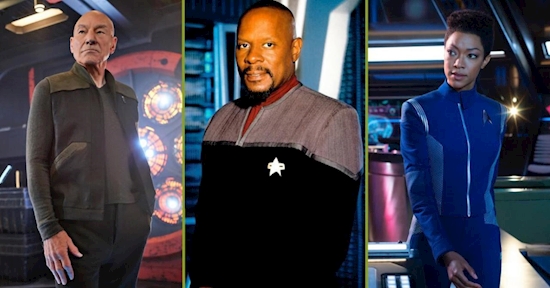Star Trek: Picard and Discovery Have Made Deep Space Nine More Important Than Ever
Star Trek: Deep Space Nine has long been considered the black sheep from the golden age of Star Trek. Spinning out of the Star Trek: The Next Generation episode "The Best of Both Worlds," Deep Space Nine broke a lot of unspoken rules of the franchise. It took place on a space station instead of a starship. The lead character -- Benjamin Sisko, played by Avery Brooks -- was a commander and not a captain (in addition to being a Black man). It dabbled in darkness and serialized storytelling, at times outright challenging the core assumptions of Gene Roddenberry's future vision. But the new streaming era of Star Trek has made the one-time odd duck of the franchise the most important of the shows from the 1990s.
We've written before aboutStar Trek: Discoverytaking on themes first broached in Deep Space Nine. Discovery's first season spun a dark, serialized, wartime narrative akin to Deep Space Nine's Dominion War. Discovery's second season touched on where faith fits into a world of science and exploration as Deep Space Nine did by casting Sisko as "The Emissary" of the Bajoran Prophets. Discovery also brought back Section 31, the controversial shadow organization introduced in Deep Space Nine.
Star Trek: Picard took Deep Space Nine's influence beyond thematics and into specific events. Some fans were baffled by the compromised and compromising state of the Federation. Though never mentioned by name in the show's first season, showrunner Michael Chabon confirmed extra-textually that much of the Federation's new attitude is the result of having fought the Dominion War.
The Dominion War took place after the conclusion of The Next Generation and is mentioned only in passing in the films that followed. The crew of the USS Voyager was stranded in the Delta Quadrant while the war raged at home. If you never watched Deep Space Nine, you'd have no sense of the gravity of the Dominion War from watching The Next Generation or Star Trek: Voyager alone. For the state of the Federation in Picard to make sense compared to its optimistic prosperity in The Next Generation, Deep Space Nine is required viewing.
To date, Deep Space Nine's relationship to modern Star Trek has is built on indelible but understated influence. The themes of Discovery are indirect, and even Section 31's presence doesn't draw an obvious connection to Deep Space Nine's core characters and narrative. Star Trek: Picard is an obvious successor to The Next Generation with a Voyager character, Seven of Nine, in a key supporting role. Despite owing much of its background to Deep Space Nine, Picard offers no direct mention outside of an Easter egg.
But Deep Space Nine's influence is undeniable and looks only to grow as the franchise continues to expand. A Section 31 spinoff is in the works and is likely to illuminate how the covert branch of Starfleet security became the autonomous entity introduced in Deep Space Nine. Discovery's third season remains shrouded in mystery but finds the Federation reduced from its height. As Picardfurther examines the state of the Federation and Starfleet, the series should illuminate the scars left by the Dominion War.
Deep Space Nine showrunner Ira Steven Behr, in conversation with ComicBook.com in 2019, alluded to how the advent of streaming television is likely one of the reasons that Deep Space Nine has seen newfound recognition among fans. It's easier to appreciate the show's long-form storytelling when you're not worried about missing an episode week to week. It seems appropriate that Deep Space Nine should benefit from the streaming era's new viewing habits as much as the CBS All Access shows that it preceded. If you want a fuller grasp of what modern Star Trek is and where it's headed, Star Trek: Deep Space Nine is essential viewing.
Disclosure: ComicBook is owned by CBS Interactive, a division of ViacomCBS.
Source: comicbook.com

